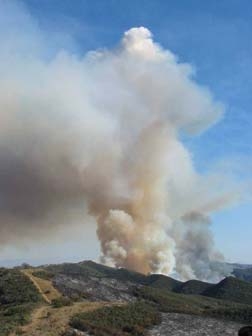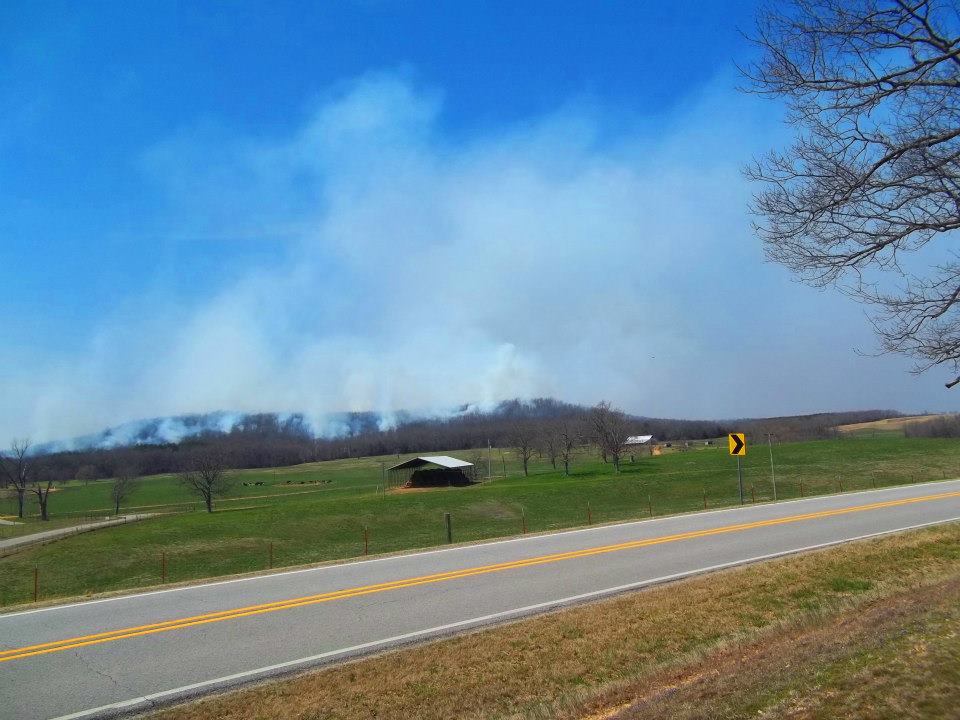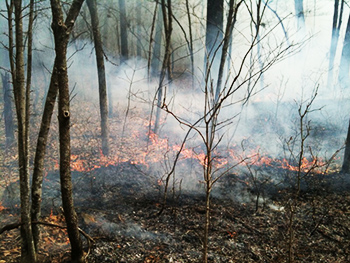Smoke Management & Prescribed Fire in Arkansas

Why perform a prescribed fire?
- Without fire, shade-tolerant trees proliferate in the under-story and crowd out the
plants and animals specifically adapted to the region's pine & oak forests. Plant species that require sunlight and provide food sources – like oaks, grasses
and wildflowers – can't reproduce.
- These crowded conditions also increase the risk of intense, uncontrollable wildfires. The destruction caused by other natural disturbances such as ice and tornadoes
is also increased by forest crowding.
- As native plants disappear and incompatible land practices increase, wildlife habitat
decreases and soil erosion and invasive plant species become increasingly problematic.
2019 Voluntary Smoke Management Guidelines for Row Crop Farmers
Before conducting a prescribed burn, conduct the following steps:
- Prepare a burn plan using the Planning a Burn Checklist from the Arkansas Prescribed Fire Network
- Check Arkansas Forestry Commission's burn ban status for your county
- Notify Arkansas Forestry Commission using their Report Prescribed Burn online form or call them at (800)830-8015. If you need to report a wildfire, call (800)468-8834
Benefits of prescribed fire include:
Hazardous Fuel Reduction
Fuel reduction is one of the most common reasons for wanting to conduct a prescribed burn. This is no more than reduction of the amount of fuel on the ground that will burn. This may include grass thatch, leaves, limbs, even logging debris and piles. The primary reason to burn for hazard reduction is to reduce the chance of a destructive wildfire. Often, this type of burn is the only objective when an area hasn't been burned in decades. Once a hazard reduction burn has occurred, additional objectives can be accomplished in subsequent burns.
Planting and Regeneration
Prescribed burning is often conducted to prepare the seedbed for mechanical, hand-planted, or natural regeneration of seedlings. By piling and burning the previous forest remains, the seedbed is open for easier access and more effective planting success. This is a common and cost-effective technique used by industrial forest product industries called "site prep burning."
Burning can remove excessive plant material, reduce competition and provide more opportunities for seed to soil contact. In addition, the fire provides a healthy dose of potash and creates a heat-absorbing black soil to further stimulate germination.
Controlling invasive vegetation with prescribed fire
Not all plant species respond to a prescribed fire equally. Many of Arkansas' native forest and grassland species respond positively to frequent, low to moderate-intensity fires. However, due to the long-standing restraint on fire management, many native, fire-intolerant species have accumulated outside their historic range. Prescribed fire can be used over time to reduce or remove these species. In addition, many non-native species that have become problematic by out-competing native plants for resources can likewise be managed with fire over time, especially in combination with other effective treatments like herbicide.
Insect and Disease Control
The direct impact of prescribed fire on many insect or disease infestations is not completely understood. In many cases destructive outbreaks occur when forest or grassland conditions have become unhealthy and succumb to normal fluctuations in insect and disease populations.
The exception to this is when a non-native competitor such as the emerald ash borer or chestnut blight is introduced. Prescribed fire can help maintain forest and grassland vigor through reduction of dead leaf and grass layers, keeping forest density at lower levels, and encouraging a healthy influx of new growth.
There is also some evidence that smoke may play a role in helping some plants defend themselves from certain insect or disease infestations.
Wildlife Habitat Improvement
Roughly 84 percent of Arkansas' native wildlife is adapted to open or semi-open habitats that were historically maintained by a regular fire. Without fire, many of these species have become less competitive or have been driven out to find more suitable habitats. Research shows the absence of regular fire is largely responsible for the decline in Arkansas' quail population. Frequent fire stimulates those plants that provide the best food sources for Arkansas' native animals, including the state's most popular game species. In addition to food sources, fire can create a diverse habitat that provides nesting, hiding and mating opportunities.
Publications
| Number | Title |
|---|---|
| FSA5009 | Why We Burn: Prescribed Burning as a Management Tool |
| FSA5016 | The Clean Air Act and Prescribed Fire: What It Means for Arkansas |
 |
Arkansas Voluntary Smoke Management Guidelines Arkansas Forestry Commission |
 |
Fire history of oak–pine forests in the Lower Boston Mountains, Arkansas, USA by R.P. Guyette and M.A. Spetich | Forest Ecology and Management 180 (2003) 463–474 |
Additional Resources
- Arkansas Forestry Commission
- Predictive Models and Tools - Southern Fire Exchange
- Agriculture and Air Quality - US EPA

